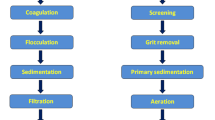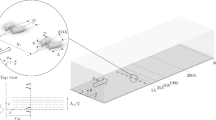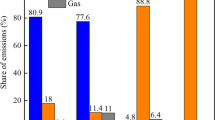Abstract
Taking wall-flow diesel particulate filter (DPF) as the research objective and separately assuming its filtering wall to be composed of numerous spherical or cylindrical elements, two different mathematical models of steady filtration for wall-flow diesel particulate filter were developed and verified by experiments as well as numerically solved. Furthermore, the effects of the macroand micro-structural parameters of filtering wall and exhaust-flow characteristic parameters on trapping efficiency were also analyzed and researched. The results show that: 1) The two developed mathematical models are consistent with the prediction of variation of particulate size; the influence of various factors on the steady trapping efficiency is exactly the same. Compared to model 2, model 1 is more suitable for describing the steady filtration process of wall-flow diesel particulate filter; 2)The major influencing factors on steady trapping efficiency of wall-flow diesel particulate filter are the macro-and micro-structural parameters of filtering wall; and the secondary influencing factors are the exhaust-flow characteristic parameters and macro-structural parameters of filter; 3)The steady trapping efficiency will be improved by increasing filter body volume, pore density as well as wall thickness and by decreasing exhaust-flow, but effects will be weakened when particulate size exceeds a certain critical value; 4) The steady trapping efficiency will be significantly improved by increasing exhaust-flow temperature and filtering wall thickness, but effects will be also weakened when particulate size exceeds a certain critical value; 5) The steady trapping efficiency will approximately linearly increase with reducing porosity, micropore aperture and pore width.
Similar content being viewed by others
References
YAO Chun-de, SHAO Yu-ping, ZHANG Chun-run, ZI Xin-yun, JIANG Da-hai, DENG Cheng-lin. Flow analysis and simulation of wall-flow diesel particulate filters [J]. Transactions of CSICE, 2004, 22(6): 504–509. (in Chinese)
TAN Pi-qiang, HU Zhi-yuan, LOU Di-ming, WANG Gang, LI Zhi-jun. Effects of diesel particulate filter structural parameters on filtration performance of different size particles [J]. Chinese Journal of Mechanical Engineering, 2008, 44(2): 175–181. (in Chinese)
WALTER K. Diesel engine development in view of reduced emission standards [J]. Energy, 2008, 33: 264–271.
MARTYN V T. Progress and future challenges in controlling automotive exhaust gas emissions [J]. Applied Catalysis B: Environmental, 2007, 70: 2–15.
ZUO Qing-song, E Jia-qiang, GONG Jin-ke, LI Li-jun, CHEN Tao, WANG Shu-hui, JIA Guo-hai. Functional link neural network prediction on composite regeneration time of diesel particulate filter for vehicle based on fuzzy adaptive variable weight algorithm [J]. Journal of Information and Computational Science, 2014, 11(6): 1741–1751.
LI Xin, ZI Xin-yun, YAO Guang-tao. Investigation on regeneration of a burner in diesel particulate trap [J]. Transactions of CSICE, 2008, 26(6): 538–542. (in Chinese)
ZUO Qing-song, E Jia-qiang, ZHANG D M, GONG Jin-ke. Performance evaluation on field synergy and composite regeneration by coupling cerium-based additive and microwave for a diesel particulate filter [J]. Journal of Central South University, 2014, 21(12): 4599–4606.
ZHANG De-man, LI Shun-ming, LI Kai, BAO Xiao-feng, WANG Meng, QIN Hong-yu. Study on DOC auxiliary dpf regeneration method [J]. Journal of Mechanical Engineering, 2010, 46(24): 107–110, 117. (in Chinese)
GONG Jin-ke, LAI Tian-gui, DONG Xi-jun, MEI Ben-fu, LIU Jin-wu, YUAN Wen-hua. Numerical simulation and analysis of the flow-field in a diesel particulate trap [J]. Automotive Engineering, 2006, 28(2): 129–133. (in Chinese)
WEI Xiong, MAO Xiao-jian, ZHU Ke-qing, FENG Jing, WANG Jun-xi, JIANG Zu-hua. Control strategy of DPF regeneration based on machine technology [J]. Transactions of the Chinese Society for Agricultural Machinery, 2013, 44(11): 1–5, 11. (in Chinese)
LIU Yun-qing, GONG Jin-ke, FU Jun, CAI Hao, LONG Gang. Nanoparticle motion trajectories and deposition in an inlet channel of wall-flow diesel particulate filter [J]. Journal of Aerosol Science, 2009, 40(4): 307–323.
LIU Xun-jun. Emission and control of internal combustion engine [M]. Beijing: China Machine Press, 2003. (in Chinese)
KOLTSAKIS G C, STAMATELOS A M. Modeling catalytic regeneration of wall-flow particulate filters [J]. Ind Eng Chem Res, 1996, 35(1): 2–13.
GONG Jin-ke, LIU Yun-qing, LONG Gang, WU Gang, YU Ming-guo, YU Xuan. Characteristics of filtration and flow resistance of wall-flow diesel particulate filter [J]. Transactions of the Chinese Society for Agricultural Machinery: 2009, 40(12): 1–7. (in Chinese)
BISSETT E J. Mathematical model of the thermal re generation of a wall-flow monolith diesel particulate filter [J]. Chemical Engineering Science, 1984, 39(7/8): 1232–1244.
KONSTANDOPOULOO A G. Inertial contributions to the pressure drop of diesel particulate filters [C]// SAE Paper 2001-01-0909.
CAO J J, LEE S C, HO K F, FUNG K, CHOW J C, WATSON J G. Characterization of roadside fine particulate carbon and its eight fractions in Hong Kong [J]. Aerosol and Air Quality Research, 2006, 6(2): 106–122.
LIU Yun-qing. Mechanisms study on filtration and microwave regeneration of wall-flow diesel particulate filter [D]. Changsha: College of Mechanical and Automotive Engineering, Hunan University, 2009: 26–42. (in Chinese)
ZUO Qing-song. Research on composite regeneration & fields synergy mechanism of diesel particulate filter and its optimal control Changsha [D]. Changsha: College of Mechanical and Vehicle Engineering, Hunan University, 2014. (in Chinese)
SHANG Tao, LI Tao, LIU Xian-li, REN Lu-quan. Trapping efficiency model of fibrous DPF based on fractal theory [J]. Journal of Jilin University: Engineering and Technology Edition, 2012, 42(2): 397–402. (in Chinese)
HAYASHI H, KUBO S. Computer simulation study on filtration of soot particles in diesel particulate filter [J]. An International Journal Computers & Mathematics with Applications, 2008, 55: 1450–1460.
Author information
Authors and Affiliations
Corresponding author
Additional information
Foundation item: Projects(51176045, 51276056) supported by the National Natural Science Foundation of China; Projects(201208430262, 201306130031) supported by the National Studying Abroad Foundation of the China Scholarship Council
Rights and permissions
About this article
Cite this article
Zhang, Gj., E, Jq., Zuo, Qs. et al. Numerical simulation on trapping efficiency of steady filtration process in diesel particulate filter and its experimental verification. J. Cent. South Univ. 22, 4456–4466 (2015). https://doi.org/10.1007/s11771-015-2993-9
Received:
Accepted:
Published:
Issue Date:
DOI: https://doi.org/10.1007/s11771-015-2993-9




